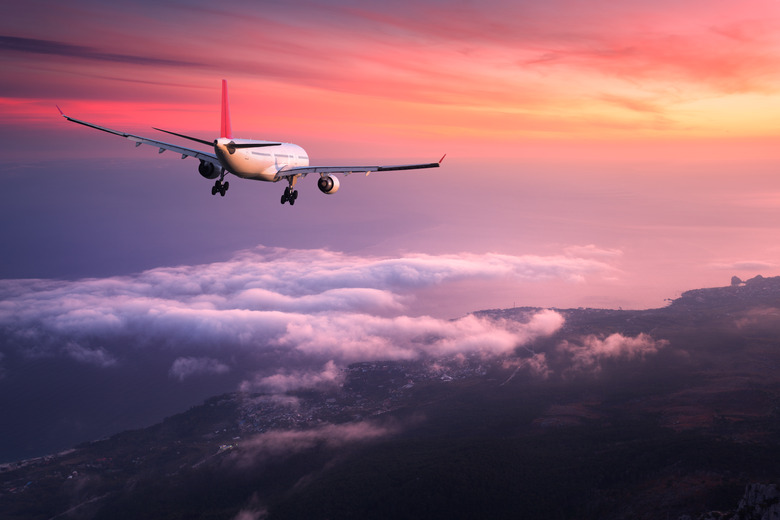What Is The Difference Between A Jet & A Plane?
One of the most common types of airplanes in use today is the jet, which has largely replaced traditional aircraft powered by propellers. Although propeller planes still see some flying action, jets dominate commercial and private air travel due to their greater speed, ability to fly at higher altitudes and mechanical reliability.
TL;DR (Too Long; Didn't Read)
The key difference between jets and propeller planes is that jets produce thrust through the discharge of gas instead of powering a drive shaft linked to a propeller. This allows jets to fly faster and at higher altitudes.
Jets versus Planes
Jets versus Planes
Jet aircraft have several distinct advantages over traditional propeller planes. The largest of these advantages is that jets can travel much faster than propeller planes, up to and beyond the speed of sound.
Jets can also travel at higher altitudes due to the specific needs of their propulsion systems. Propellers require dense air to engage the spinning blades, whereas jets employ turbochargers to compress even the thin air that exists in the stratosphere until it is suitable for combustion in the jet engine. Flying higher allows planes to avoid turbulence that occurs at lower altitudes and also increases the number of aircraft in the skies since they can operate at different altitudes.
Jets can also use their greater power to propel larger aircraft, including the class of oversized jumbo jets. This advantage makes jet engines suitable for cargo and military aircraft where heavy payloads are routine.
Development of Jet Planes
Development of Jet Planes
Jet-powered aircraft have existed as experimental models or designs on paper since the earliest days of aviation. British and German engineers turned more attention to the development of jet aircraft following World War I, when aviation had proven so vital.
The onset of the second World War galvanized these efforts. The first practical plane fully powered by jet engines was the German Heinkel He 178 in 1939. Meanwhile, the first Italian-designed jet, the Campini N.1, took its first flight in 1940, and the British Gloster E.28/39 took test runs in 1941. The United States entered the jet race with its Bell XP-59 in 1942.
Jet planes were too late to prove effective in World War II, where propeller planes still dominated, but jets were important to the Korean War and all wars thereafter. Commercial jet service began in the early 1950s, and today jets dominate the majority of medium- and long-distance flights around the world.
Propeller Planes
Propeller Planes
Despite the popularity of jet planes, propeller planes still serve important roles. Most major airlines use propeller planes for short regional flights since they are less expensive to maintain and operate. Declining revenues during challenging economic times prompted cancellation of jet service to many smaller airports, and in some cases, propeller plane service filled the gap.
This, however, represents a challenge to airlines who must combat a negative public view of propeller planes. Passengers complain about the turbulence and noise of propeller planes as well as the perceived lack of safety and slower speed of travel. Still, their small size and lower fuel consumption make propeller planes a vital part of operations for airlines struggling to lower their costs while maintaining a broad service network.
General Airplane History
General Airplane History
While efforts toward powered flight date back to the earliest inventors, the first successful flight of a fixed-wing aircraft is the famous one piloted by the Wright brothers in 1903. Their plane, known as the Wright Flyer I, was made of wood and used a gasoline engine to spin a pair of wooden propellers. Over the next several years, the Wright brothers continued to refine the design that would provide the basis for aircraft over the coming decades.
World War I provided a major incentive for the design and construction of better airplanes. Planes originally functioned as surveying equipment for ascertaining enemy positions. This led to aerial bombardment with heavy objects and hand grenades and prompted the mounting of guns to planes for defense. Following the war, the world saw the beginning of the civilian aviation industry, promoted by hero pilots like Charles Lindbergh in the 1920s.
Cite This Article
MLA
Hartman, Dennis. "What Is The Difference Between A Jet & A Plane?" sciencing.com, https://www.sciencing.com/difference-between-jet-plane-5263274/. 21 May 2018.
APA
Hartman, Dennis. (2018, May 21). What Is The Difference Between A Jet & A Plane?. sciencing.com. Retrieved from https://www.sciencing.com/difference-between-jet-plane-5263274/
Chicago
Hartman, Dennis. What Is The Difference Between A Jet & A Plane? last modified March 24, 2022. https://www.sciencing.com/difference-between-jet-plane-5263274/
